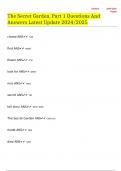Summary
Summary of List of Infectious Diseases for Exam Containment Strategies
- Course
- Institution
- Book
A compact summary of the infectious diseases required to know for the Containment Strategies exam. Not all diseases covered in chapter 7-17 are covered in this summary, as not all diseases were required for the exam. New and Emerging Diseases is NOT included. Book was used to make the summary. T...
[Show more]













